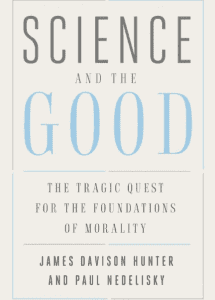 James Davison Hunter and Paul Nedelisky, in their new book called Science and the Good: The Tragic Quest for the Foundations of Morality, sketch the results of 500 years of the “scientific” study of morality.
James Davison Hunter and Paul Nedelisky, in their new book called Science and the Good: The Tragic Quest for the Foundations of Morality, sketch the results of 500 years of the “scientific” study of morality.
What has science achieved? (That’s their question.)
Another question is What kind of results has it achieved? They begin with a brief on what science is:
A more robust definition of science attempts to tie it to the observation of empirical data, mathematical representability, testability, and falsifiability of hypotheses.
Though it did not appear to me to have the weight that it gained as the chapter moved forward, they distinguish Three Levels of moral/scientific knowledge. What can science achieve if one distinguishes these three levels of moral knowledge?
Can science lead us to Level 1, to Level 2, or to Level 3?
Level One results would provide specific moral commands or claims about what is genuinely valuable. They would demonstrate with empirical confidence what, in fact, is good and bad, right and wrong, or how we should live.
“Level Two” findings, while falling short of demonstrating some moral doctrine, would still give evidence for or against some moral claim or theory.
“Level Three” findings would provide scientifically based descriptions of, say, the origins of morality, or the specific way our capacity for moral judgment is physically embodied in our neural architecture, or whether human beings tend to behave in ways we consider moral. Evidence for these sorts of views doesn’t tell us anything about the content of morality—what is right and wrong—but they speak to the human capacity for morality and in that sense are interesting.
They discuss the major conclusions of the best scholarship in the most respectable publications in terms of altruism and in terms of cognitive decisions. Thus the examine…
Evolutionary biology (kin selection)
Evolutionary psychology
Primatology (Capuchin monkeys)
Neuroscience (dual process of moral judgment)
Social psychology
Then they look at Moral Foundation Theory (Jonathan Haidt), and his six-fold scheme: “So far, Haidt has identified six basic moral ‘tastes’ or modules: (i) care/harm, (2) fairness/cheating, (3) loyalty/betrayal, (4) authority/subversion, (5) sanctity/degradation, and (6) liberty/oppression.”
So, their conclusion is what?
After five hundred years of scientific inquiry into the nature of morality, the most noteworthy scientific findings at best achieve Level Three status. Moral foundations theory describes basic and important moral emotions; research in evolutionary biology has uncovered promising mechanisms that illumine how other-regarding behavior could have evolved.
But as far as we can tell, there are no scientific findings that present claims of either Level One or Level Two status. Even the renewed energies of the new synthesis have provided no clear empirical support for any moral theory, let alone for any claim about what is right and wrong, good or evil, or how we should live.











